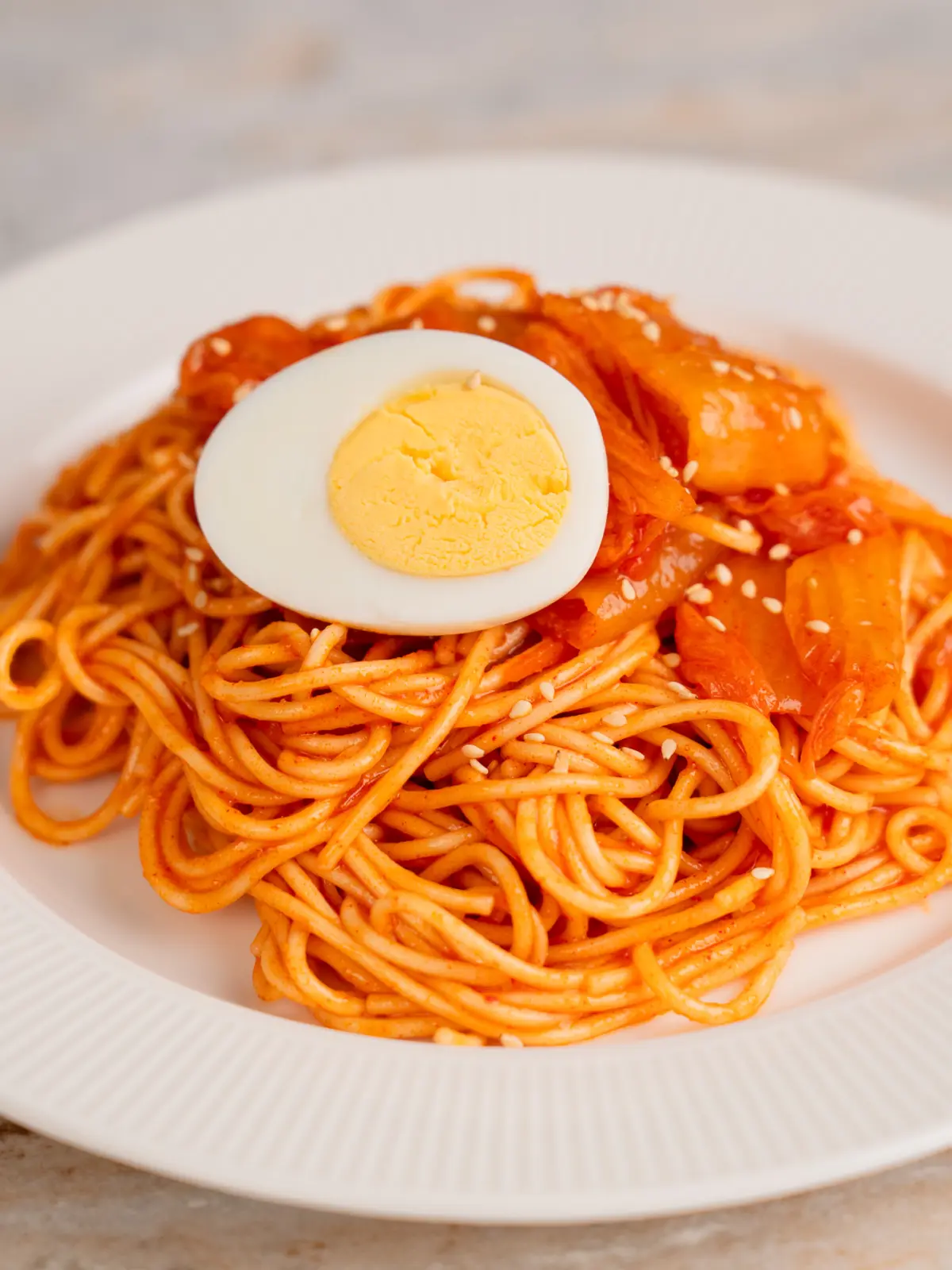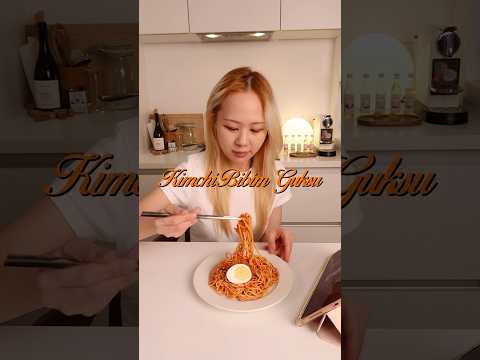Let’s make Kimchi Bibim Guksu (Korean spicy cold noodles), the simplest yet most authentic Korean noodle dish! Today, I’m also sharing my Korean mom’s kimchi bibim guksu recipe-a perfect balance of heat, spice, and umami that takes this dish to the next level. Get ready for a bowl of noodles that’s both refreshing and packed with flavor!
Table of Contents
What is Kimchi Bibim Guksu? 김치 비빔국수
Kimchi Bibim Guksu is a spicy Korean cold noodle dish made by mixing thin noodles, such as somyeon (wheat noodles) or jungmyeon (medium-thin noodles), with a flavorful seasoning sauce that includes kimchi and gochujang (Korean red pepper paste).
Unlike regular Bibim Guksu, this version has an added tanginess from kimchi, enhancing its refreshing and appetite-boosting qualities. The kimchi seasoning also deepens the umami flavor, making it an irresistible summer dish.
What Do Spicy Cold Noodles Taste Like?
Kimchi Bibim Guksu has a spicy base of gochujang combined with the tangy flavor of kimchi. Sugar or plum extract is often added to balance the heat with a subtle sweetness, creating a well-rounded sweet and sour kick. In Korea, cold noodle dishes are known for their chewy texture, which is a key factor in their deliciousness. The secret to that perfect chewy bite? Read on to find out!

A Popular Summer Dish in Korea
Kimchi Bibim Guksu is a beloved summer spicy noodles in Korea, especially when the heat reduces appetite. The tangy kimchi helps refresh the palate, while the chilled noodles provide a cooling effect, making it a go-to meal on hot days. Many Koreans also enjoy topping it with cucumber slices, which add a refreshing crunch and enhance the overall cooling sensation.
The Charm of Kimchi Bibim Guksu
Kimchi Bibim Guksu is a dish that perfectly balances spicy, tangy, and sweet flavors, making it incredibly refreshing and satisfying. It’s an ideal light and cooling meal for hot summer days, especially when you don’t want to spend too much time in the kitchen. With just kimchi and gochujang, you can quickly whip up a delicious bowl of noodles in no time! It’s an easy bibim guksu recipe.
How to Cook Noodles Perfectly
The key to a great bowl of Kimchi Bibim Guksu(kimchi cold noodles) lies in the chewy texture of the noodles. Here’s how to achieve it.
Boil the Noodles
- Add the noodles to boiling water.
- When the water starts to foam and rise, add a cup of cold water to bring the temperature down.
- Bring to a boil again and repeat the process. This technique makes the noodles extra chewy.

Rinse the Noodles
- Rinsing in cold water is extremely important for achieving a firm, bouncy texture.
- If possible, rinse the noodles in ice water for an even better result.
- Rinse the noodles thoroughly under very cold running water to remove excess starch – this will help them stay firm and elastic instead of becoming mushy.
The Perfect Seasoning Ratio
When making the sauce for Kimchi Bibim Guksu, you don’t need too much gochujang! The ideal balance comes from gochujang, soy sauce, vinegar, and sugar in a 1:2:1~2:1 ratio.
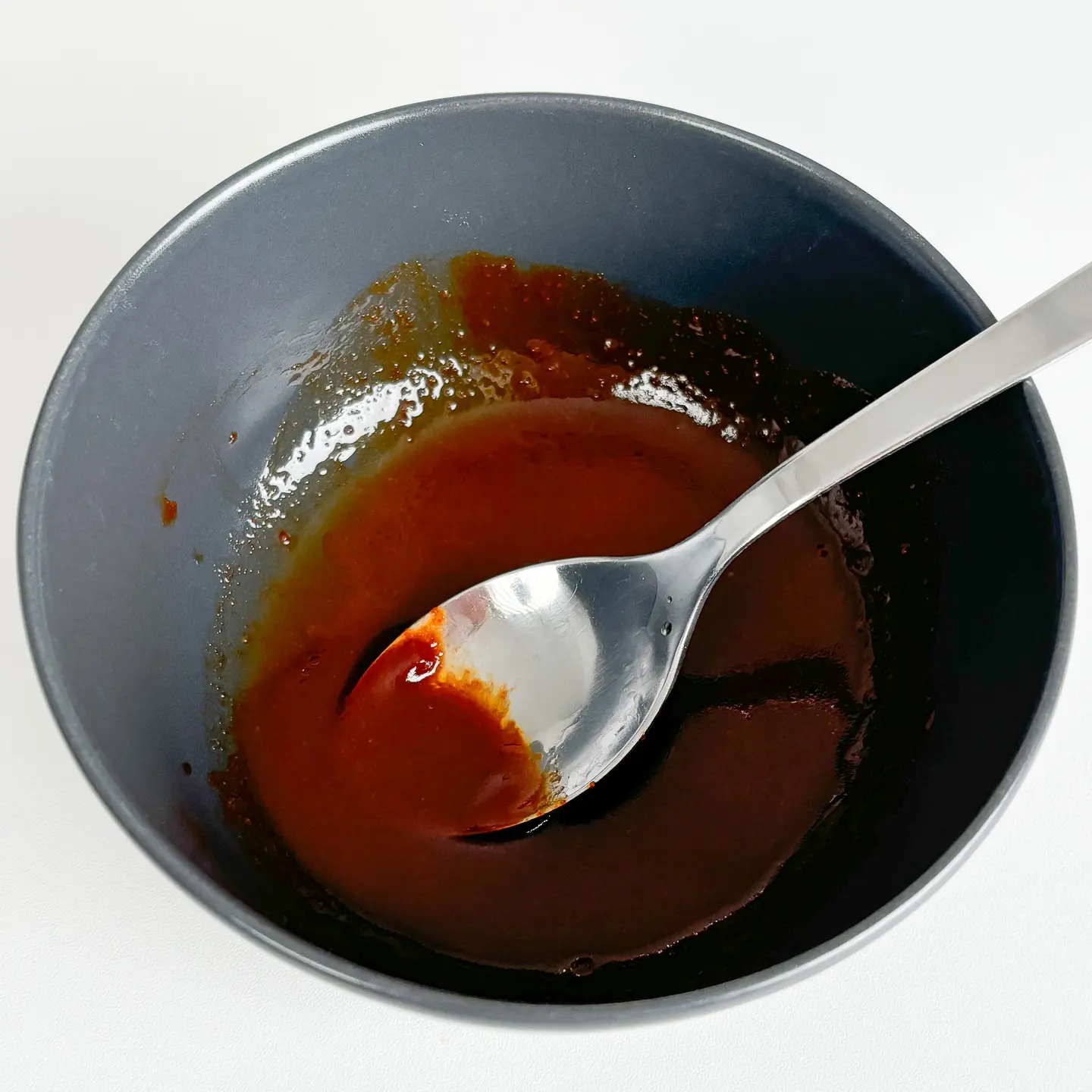
- Why is vinegar adjustable (1~2)? If your kimchi is very aged and sour, you can reduce the vinegar slightly.
- Not a fan of sweetness? Feel free to use less sugar.
- There’s no strict rule for seasoning! Adjust it to match your taste.
- Sesame oil? I personally use 1 part, but you can add more or less depending on your preference.
Korean Mom’s Secret Tip
Instead of adding garlic or other seasonings, simply add 1 spoonful of kimchi juice! It enhances the umami and depth of flavor, making the bibim guksu taste incredibly rich and authentic.
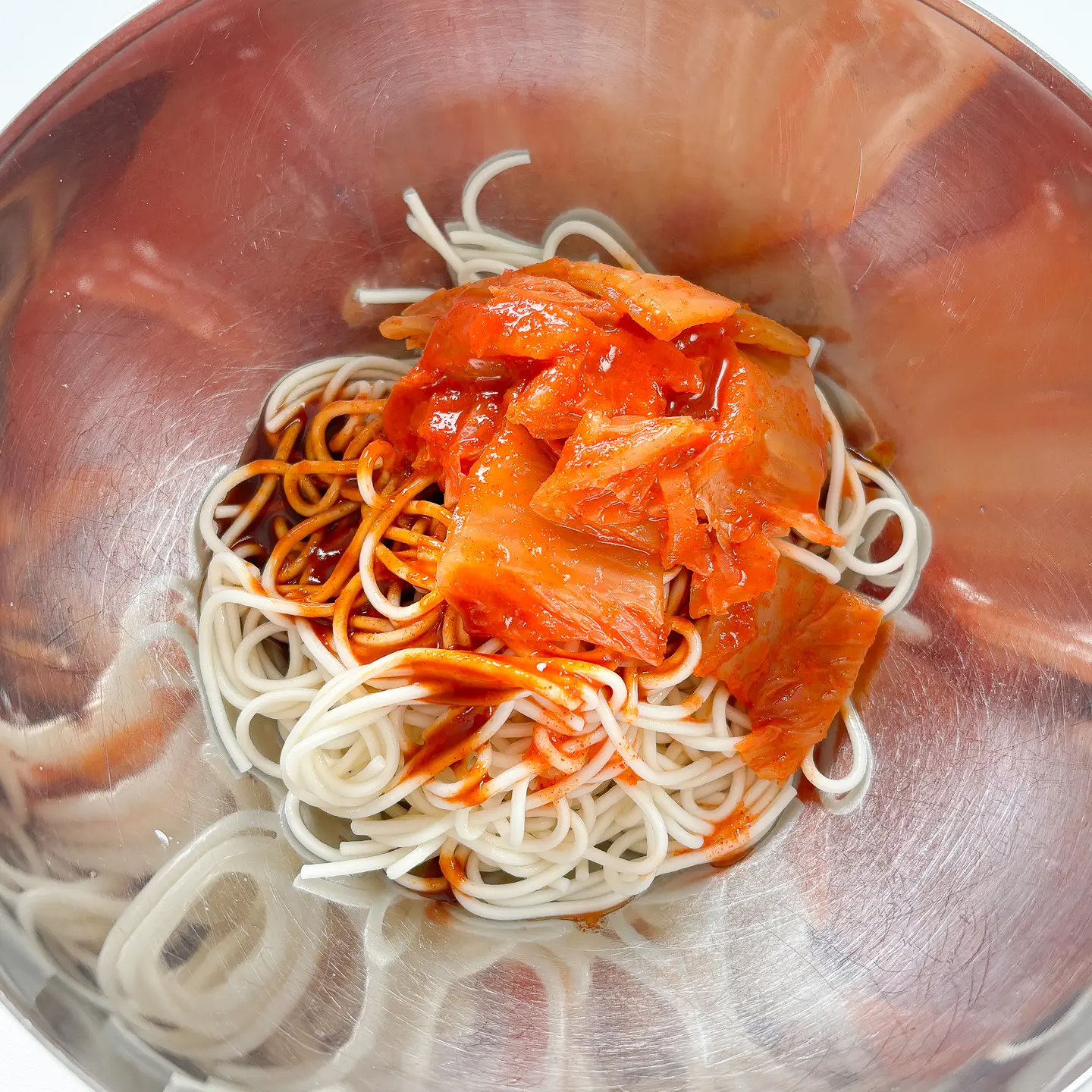
Which Noodles for Bibim Guksu?
In Korea, the most common noodle for Bibim Guksu is somyeon, the thinnest wheat noodle. It’s perfect for this dish because it absorbs the seasoning easily and cooks very quickly. If you prefer a chewier texture, you can use slightly thicker jungmyeon (medium-thin noodles). I personally use jungmyeon for a bit more bite!
- Somen
- https://amzn.to/3Y0ZPIs (US), https://amzn.to/3FBBR0m (NL, BE), https://amzn.to/4iHGODe (DE)
What’s the Difference Between Bibim Guksu and Bibim Naengmyeon?
Both dishes share the same spicy, tangy seasoning, but the biggest difference is the noodles.
- Bibim Guksu uses somyeon, a wheat noodle that’s thin and soft.
- Bibim Naengmyeon uses buckwheat noodles, which are known for being much chewier and springier.
Additionally, Bibim Naengmyeon often includes a small amount of cold naengmyeon broth to enhance the cooling effect, while Bibim Guksu is served with just the sauce.
Recommended Toppings for Kimchi Bibim Guksu
- Hard-boiled Egg: Adds protein and helps neutralize the spiciness for those who may not handle spicy foods well.
- Cucumber: Thinly sliced cucumber adds refreshing crispness and extra texture, along with a healthy dose of vitamins.
- Roasted Sesame Seeds: Sprinkle these for a delightful crunch and a rich, nutty flavor as you eat.
- Seaweed (Gim): Add seasoned seaweed flakes for a salty, umami kick that amplifies the dish’s overall depth of flavor.
- https://amzn.to/3FHMgrm (US), https://amzn.to/41NawRv (DE), https://amzn.to/422C4AX (NL, BE)
- Buldak Sauce: If you, like me, love extreme spiciness, try adding a bit of Buldak sauce. Buldak Bibim Guksu is my favorite combination!
- https://amzn.to/42duK6Z (US), https://amzn.to/429KIxR (DE), https://amzn.to/4j8vnoe (NL, BE)
What Goes Well with Kimchi Bibim Guksu?
Koreans love pairing Kimchi Bibim Guksu with other dishes. These can either be side dishes or another main dish. Here are some popular food pairings.
- Mandu (Dumplings)
When you visit noodle shops in Korea, you’ll often see Mandu on the menu. Koreans enjoy eating dumplings as a side dish with both soup-based and bibim guksu dishes. Sometimes, eating just the noodles can leave you feeling hungry quickly, so adding dumplings helps fill you up and adds some protein, all while bringing variety to the flavors.
Here’s a great pairing idea: Cheese Mandu with Bibim Guksu. The richness of cheese adds a fun contrast to the spicy noodles!
- Jeon (Korean Pancakes)
In Korean noodle shops, it’s common to see jeon (savory pancakes) as a side dish. The greasy texture of jeon balances the spicy and tangy flavor of the bibim guksu. It creates a harmonious food pairing, making the flavors complement each other perfectly.
- Korean BBQ (Samgyeopsal, pork belly)
Many Koreans like to enjoy their bibim guksu with some grilled pork belly (samgyeopsal). Grilling the meat and pairing it with bibim guksu gives you protein while the rich, fatty taste of the pork balances the spicy noodles, creating an amazing flavor combination.
- Kimbap
You may also see kimbap paired with bibim guksu in Korean snack shops. Kimbap helps mellow out the spiciness of bibim guksu and provides a range of flavors and nutrition. This combination is popular, especially in quick-service places like snack bars.
Various Types of Bibim Guksu (Mixed Korean Noodles)
In Korea, there are many mixed dishes like bibimbap and bibim guksu, where different ingredients are combined to create balanced flavors. Bibim guksu also comes in various types, each offering its own unique flavor profile. Let’s take a look at some popular Korean bibim guksu varieties.
- Kimchi Bibim Guksu (김치비빔국수)
This is the recipe I’ll be showcasing today. It’s a spicy bibim guksu made with a gochujang (Korean chili paste) base and combined with kimchi, either napa cabbage or young radish kimchi, to create a tangy and spicy flavor. It’s one of the simplest yet most beloved dishes for Koreans, especially during the summer, making it a true comfort food that instantly brings thoughts of the hot season.

- Ganjang Bibim Guksu (간장비빔국수)
A soy sauce-based bibim guksu that is sweet and salty, often enjoyed cold. The addition of sesame oil at the end provides a rich, nutty aroma that truly stimulates the taste buds. This version is not spicy, making it a great option for kids. In the past, some noodle shops would offer this as a “baby noodle” dish, serving it as a free side or selling it for a mere 1,000 KRW. Below is the recipe to recreate this nostalgic ganjang bibim guksu(soy sauce Korean noodles) in just 10 minutes, one of the classic noodle dishes loved by Koreans.
- Jjangban Makguksu (쟁반막국수)
The seasoning for Jjangban Makguksu is similar to spicy bibim guksu, but it’s served in a unique way. The noodles are placed in the center of a large platter, surrounded by a variety of vegetables like carrot, cucumber, and lettuce. The spicy seasoning is poured on top, creating a refreshing, mixed dish that’s often eaten in large quantities. It’s typically shared between 2-3 people, offering a hearty and spicy meal that’s perfect for group dining.
Bibim Guksu Substitute Ingredients
If you don’t have gochujang (Korean chili paste) or soy sauce, don’t worry! You can just buy Korean bibim myun (bibim noodles) in the store. These ready-made noodles come with a package of sauce, so there’s no need to buy gochujang, soy sauce, and noodles separately. It’s super convenient and quick!
- Paldo Bibim myun: https://amzn.to/4iwzQAr (US), https://amzn.to/4iqLzk8 (DE)
- Bibim Sauce: https://amzn.to/3DnBHbZ (NL, BE), https://amzn.to/43pnaao (US)
Be aware, however, that the taste will be quite different from the homemade version with my mom’s special sauce recipe. While bibim myeon has its own unique flavor, the experience of making bibim guksu from scratch, mixing the ingredients to your personal preference, has its own special charm.
So, depending on what you’re in the mood for, you can choose between the convenience of bibim myeon or the authentic homemade bibim guksu with my sauce. Both have their own appeal, so enjoy whichever option suits your taste and time!
Get Ingredients Here
- Kimchi
- Somen
- https://amzn.to/3Y0ZPIs (US), https://amzn.to/3FBBR0m (NL, BE), https://amzn.to/4iHGODe (DE)
- Gochujang
- https://amzn.to/3XstNFi (US), https://amzn.to/4hSoh65 (DE), https://amzn.to/4l4b2BU (NL, BE)
- Soy Sauce
- https://amzn.to/4gYk1BJ (US), https://amzn.to/4gW8zGv (DE)
- Sesame oil
- https://amzn.to/3QCZIyE (US), https://amzn.to/43fg5cn (DE), https://amzn.to/4bdP8Ys (NL, BE)
- Sesame seeds
- Korean Vinegar
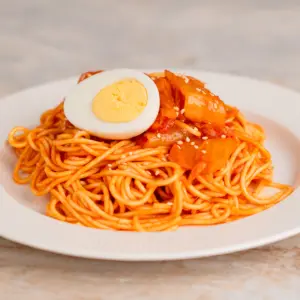
Korean Mom’s Kimchi Bibim Guksu (Spicy Cold Noodles)
Equipment
- 1 scissors
- 1 Pot
- 1 Tongs
- 1 Bowl
- 1 Strainer
Ingredients
- 1 serving noodles
- 2 leaves kimchi
- 1.5 tbsp kimchi juice (Korean mom's tip!)
Bibim Guksu Seasoning Sauce
- 0.5 tbsp gochujang (Korean red pepper paste)
- 1 tbsp soy sauce
- 1 tbsp vinegar
- 1 tbsp sesame oil
Toppings (Optional)
- 1 boiled egg
- 1 pinch sesame seeds
Instructions
- Cook the noodles in boiling water. For a chewy texture, add a bit of cold water when it first starts to boil and continue cooking. Check the package instructions for the exact cooking time, as it varies by noodle type.
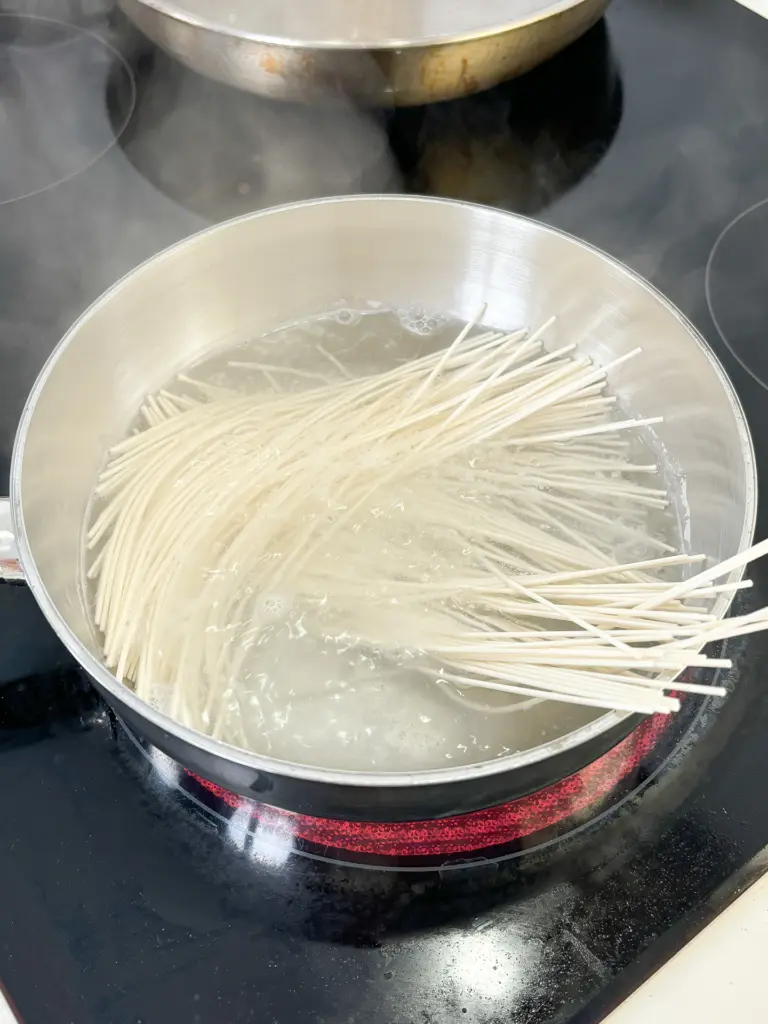
- Rinse the cooked noodles under cold water while rubbing them gently. This makes them extra chewy.
- Cut the kimchi into small pieces using scissors.
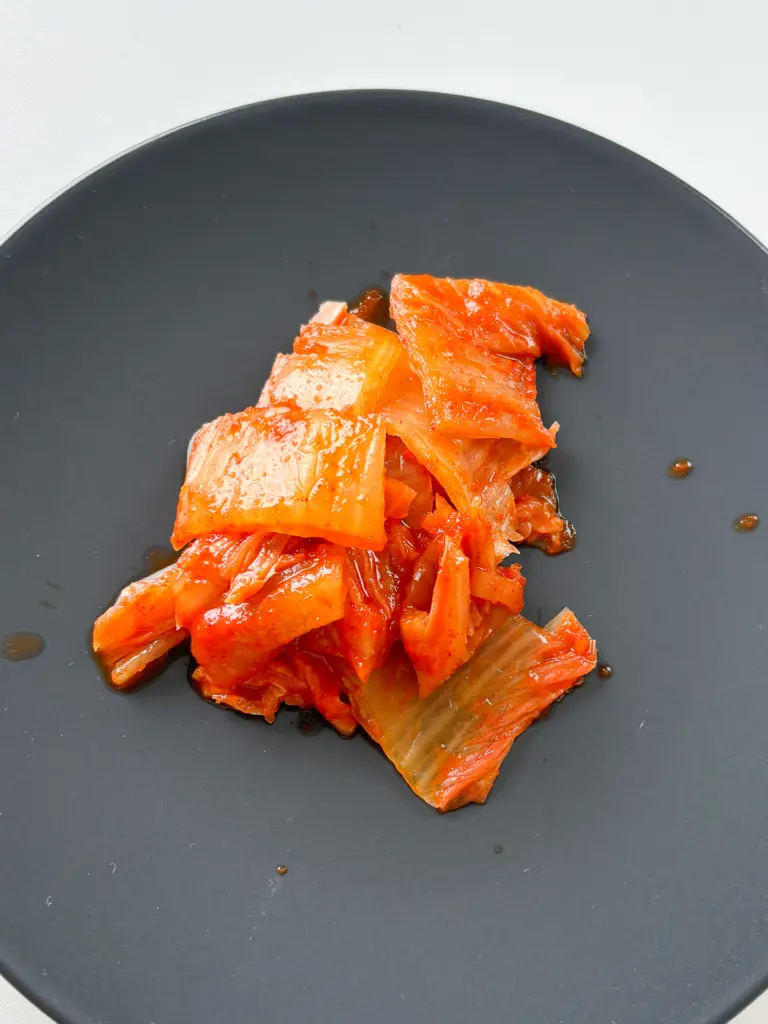
- Make the seasoning sauce: Mix 0.5 tbsp gochujang, 1 tbsp soy sauce, 0.5 tbsp sugar, 1 tbsp vinegar, 1 tbsp sesame oil If the kimchi is very sour, reduce the vinegar to 0.5 tbsp.
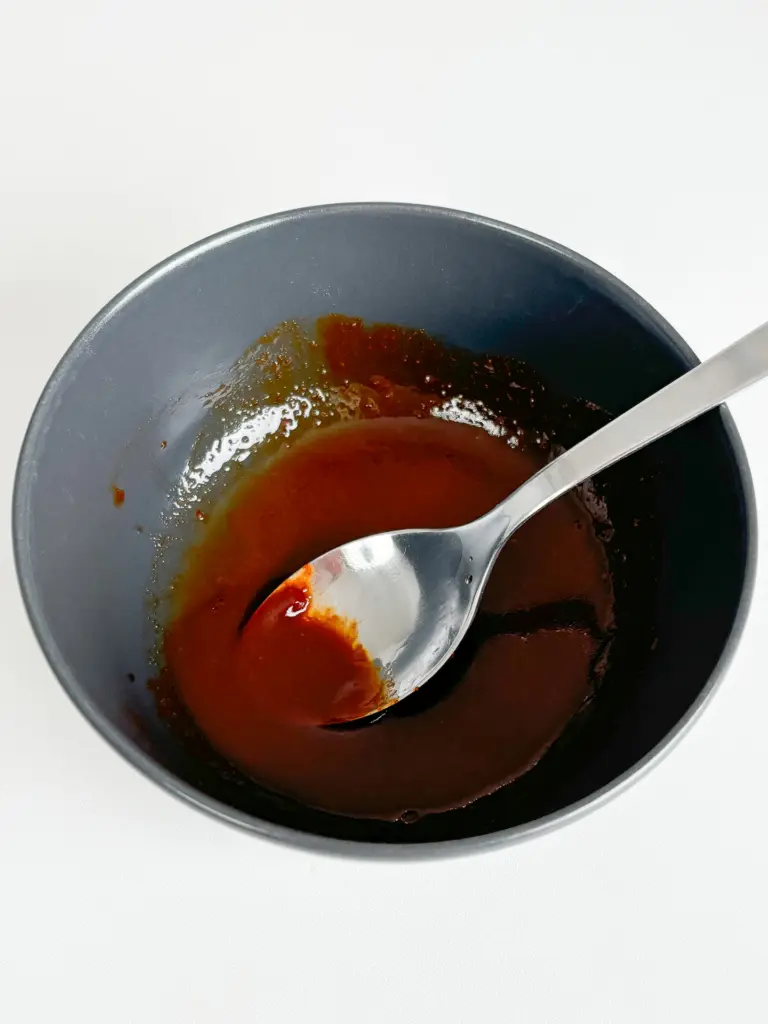
- Add the kimchi and seasoning sauce to the noodles. Korean Mom’s Tip! Adding 1 to 1.5 tbsp of kimchi juice enhances the umami flavor of bibim guksu. Mix everything well.
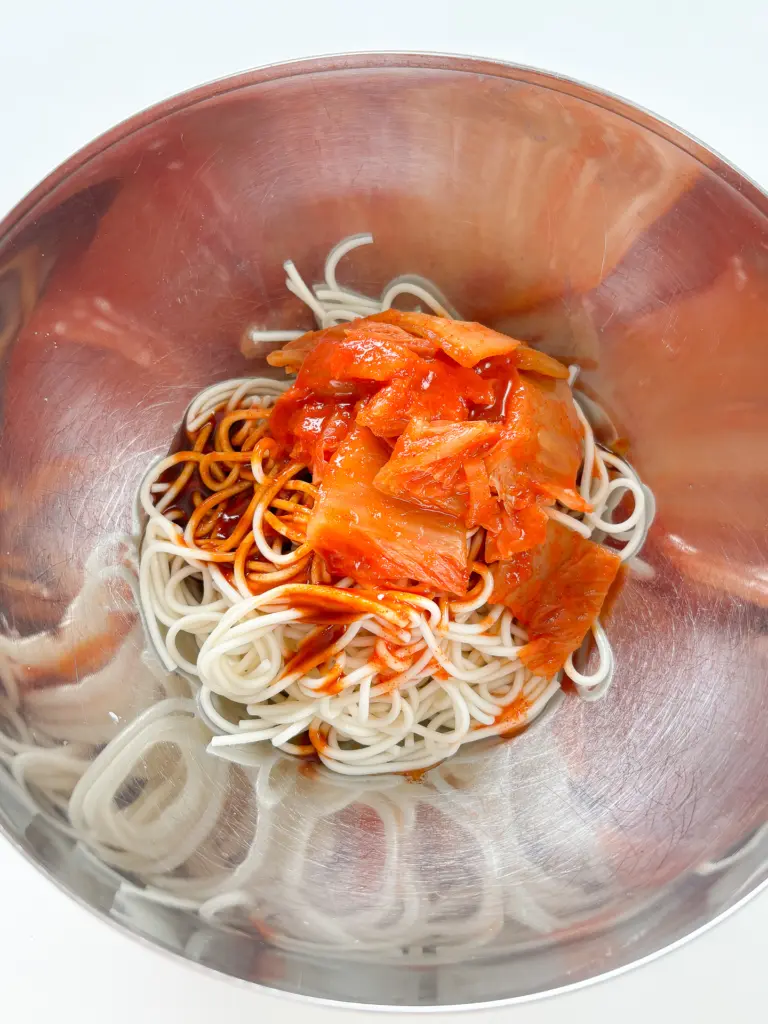
- Plate the noodles and top with a boiled egg and sesame seeds. You can also add cucumber garnish for extra freshness.
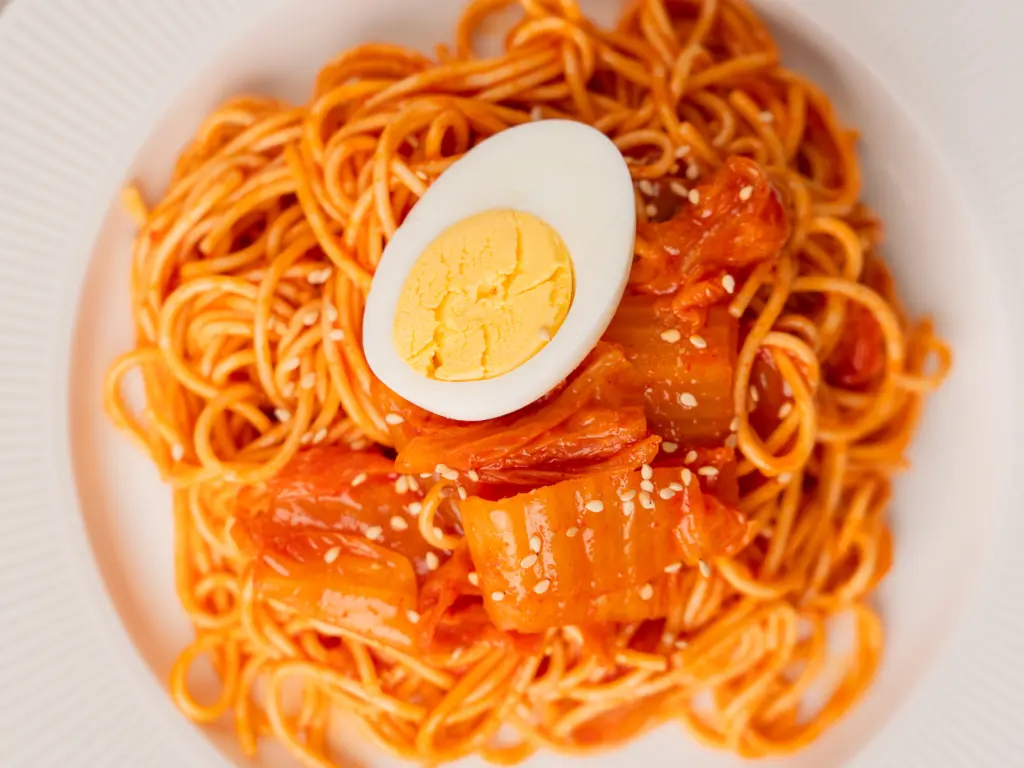
Kimchi Bibim Guksu 김치 비빔국수
- Jal Meokgetseumnida! 잘 먹겠습니다!
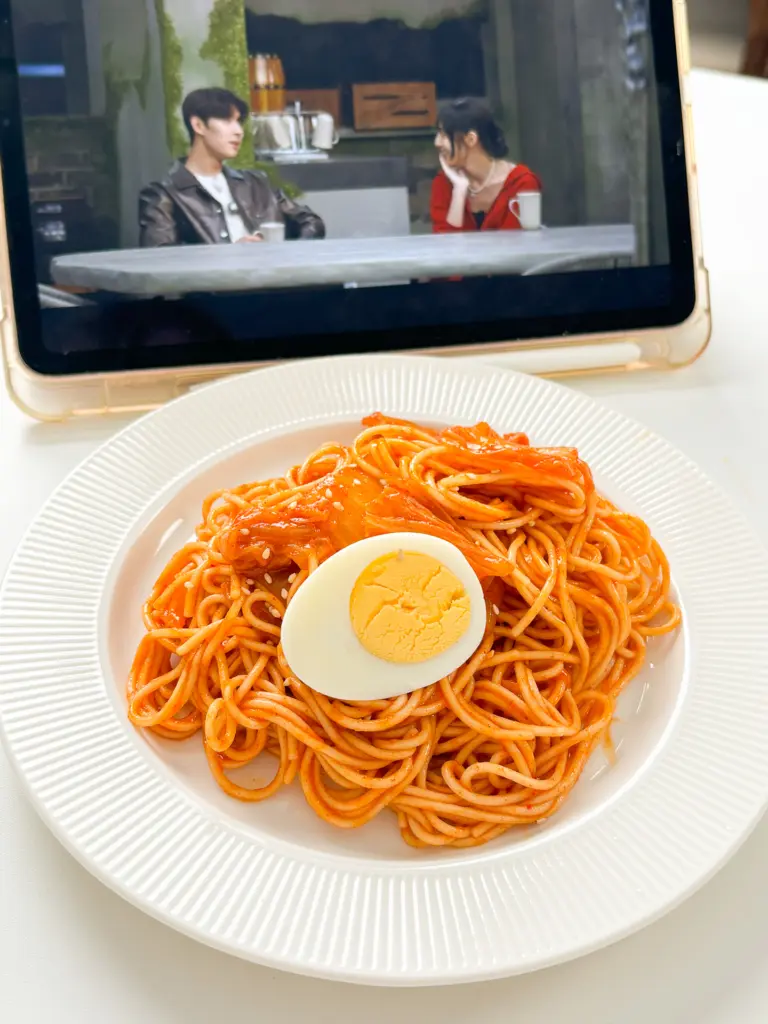
Did you make this recipe?
Please let me know how it turned out for you! Leave a comment below and tag @blondekimchi_ on Instagram and hashtag it #blondekimchi.
